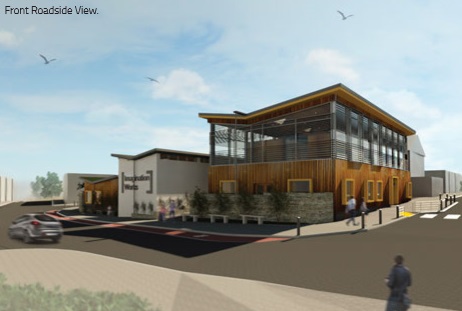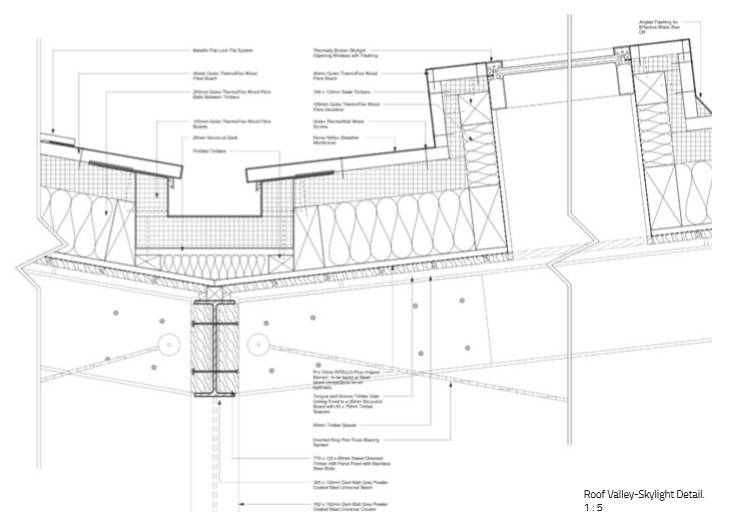Imagination Works
A demonstration of innovative use of technology, which has been benchmarked against the environmental strategy, Gerard Langleys’ Imagination Works — Embracing an Urban Future receives Commended for the Student Award for Excellence in Architectural Technology (Project) 2017.
A demonstration of innovative use of technology, which has been benchmarked against the environmental strategy, Gerard Langleys’ Imagination Works — Embracing an Urban Future receives Commended for the Student Award for Excellence in Architectural Technology (Project) 2017.
The Sharrow Lane Children’s Centre presents an introspective courtyard design, with a butterfly roof buildings approach offering inclusive and accessible site integration to define spaces within and around. Both the concepts of protection for young users, and site prominence are key to promote the design and to address the challenging urban environment.
The aim of the project was to place a children’s centre at the heart of an urban established context. The design is intended to offer the young users the best start in life. The introspective design provides spaces for children to explore and be safe in, as well as community driven aspects that provide services for parents to further their knowledge as well as providing functions that benefit the community.
The scheme presents a clay honeycomb blockwork primary system in a structural and non-structural manner. This acts as the key primary structure for the nursery zoned aspect of the design, whilst within the public building plan a steel structural frame is utilised to provide support to the upper aspect of the large adaptable spaces. Therefore the blockwork acts as an infill system for this building.
The design’s elevational response explores a classical principle of architecture; stability. This classical manner is achieved by using a denser and heavier structure at the base and creating a visually lighter appearance as the elevation rises. This approach, with the division of the buildings on the site, in plan and in elevation through site level placement creates a protected and effectively filtered building ideology.
Internally the scheme presents a centralised circulation approach to maximise daylight potential for spaces. The nursery aspect allows for a private connection to the external play spaces for the young users, whilst the public aspect provides multiple entry points and mixed use spaces including offices, retail, community, and café spaces for the diverse range of activities. Disabled facilities are also provided in the scheme, these include a changing places toilet and disabled user toilets.
Efficiency and simplicity are at the heart of the design assembly. Utilising a monolithic load bearing blockwork system that has proven effective in the UK, and exploring a concrete alternative such as clay honeycomb blocks, allow for a more efficient material in terms of environmental credentials and buildability. Using this system builds on a tried and tested solution.
For the upper storey of the public building where a lighter aspect has been implemented, the primary steel structure used allows for an off-site assembly, providing a quicker erection of the structure once placed on site, addressing the site working limits. The box windows specified also use an off-site construction for increased efficiency. These systems are utilised on the passive floor slab system that can be quickly laid with an EPS insulation build up to allow for an effective lead time in the building of the design.
Using a traditional proven construction technique of blockwork, developing the materials used, whilst also analysing the thermal detailing allows for the wall, enabled floor and roof build ups to achieve a passive standard of construction.
Whilst blockwork provides thermal mass properties, an internal insulation is utilised for the external perimeter walls to prevent excessive thermal mass gains. Therefore thermal mass is strategically integrated within the ground floor screed, upper concrete metal deck, and internal blockwork walls. The external wall build up, utilising a wood fibre insulation, contains no embodied energy, provides a passive u-value of 0.110 W/m2K. Whilst the passive floor slab system consisting of an EPS build up gives a u-value of 0.081 W/m2K. Finally the roof presents a 0.101 W/m2K u-value. This exceeds building regulations and provides details that offer no thermal bridging at key connection joints.
Moisture protection is in the form of the vertical timber cladding system fixed to a counter batten system with an engineered brick course providing protection for the sweet chestnut cladding at the ground level of the wall connection.
Judges’ comments:
Judges were drawn to the ceramic rod brise soleil and curtain wall sliding faade which would allow users to control temperature, glare and filter unwanted noise from the building. This, along with other environmental strategies such as the biodiverse green roof and a rainwater tank passively influence the cooling and heating properties of the building demonstrated a fantastic understanding for Gerard to receive the Commended Award.
This article was originally published in the AT Autumn issue 123.
--CIAT
[edit] Related articles on Designing Buildings Wiki
Featured articles and news
RTPI leader to become new CIOB Chief Executive Officer
Dr Victoria Hills MRTPI, FICE to take over after Caroline Gumble’s departure.
Social and affordable housing, a long term plan for delivery
The “Delivering a Decade of Renewal for Social and Affordable Housing” strategy sets out future path.
A change to adoptive architecture
Effects of global weather warming on architectural detailing, material choice and human interaction.
The proposed publicly owned and backed subsidiary of Homes England, to facilitate new homes.
How big is the problem and what can we do to mitigate the effects?
Overheating guidance and tools for building designers
A number of cool guides to help with the heat.
The UK's Modern Industrial Strategy: A 10 year plan
Previous consultation criticism, current key elements and general support with some persisting reservations.
Building Safety Regulator reforms
New roles, new staff and a new fast track service pave the way for a single construction regulator.
Architectural Technologist CPDs and Communications
CIAT CPD… and how you can do it!
Cooling centres and cool spaces
Managing extreme heat in cities by directing the public to places for heat stress relief and water sources.
Winter gardens: A brief history and warm variations
Extending the season with glass in different forms and terms.
Restoring Great Yarmouth's Winter Gardens
Transforming one of the least sustainable constructions imaginable.
Construction Skills Mission Board launch sector drive
Newly formed government and industry collaboration set strategy for recruiting an additional 100,000 construction workers a year.
New Architects Code comes into effect in September 2025
ARB Architects Code of Conduct and Practice available with ongoing consultation regarding guidance.
Welsh Skills Body (Medr) launches ambitious plan
The new skills body brings together funding and regulation of tertiary education and research for the devolved nation.
Paul Gandy FCIOB announced as next CIOB President
Former Tilbury Douglas CEO takes helm.
UK Infrastructure: A 10 Year Strategy. In brief with reactions
With the National Infrastructure and Service Transformation Authority (NISTA).


























